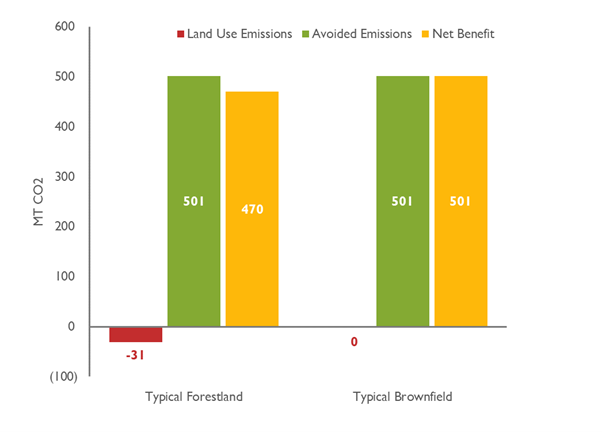Carbon Dioxide Emissions Tradeoffs: Forests or Solar Panels?
As more and more governments and corporations commit to a zero-carbon future, the need for large amounts of renewable energy installations over the coming decades increases. In densely populated New England, there is limited space for large-scale installations of solar panels.
This has sparked discussion and debate about the carbon dioxide (CO2) emissions tradeoff between installing solar panels and maintaining current land-use practices. To investigate the issue further, Synapse set out to answer the following questions within New England:
- Which offsets more CO2: one acre of forest or one acre of solar panels?
- How much CO2 is offset by solar panels if you install them on a brownfield (instead of a forest), where there is no need to clear trees?
We found that the energy production from solar photovoltaic (PV) facilities in New England reduces CO2 emissions by a much greater amount than the forestland would have, were it left untouched.
Dive into the Analysis
For a typical solar PV facility located on forested land in New England, we find that the net CO2 impact is a reduction of 470 tons per year. If the same solar PV facility were located on a brownfield site, the net CO2 impact is a reduction of 501 tons per year, as illustrated in the chart below. This means that the process of clearing one acre of forestland typically increases CO2 emissions by 31 tons per year.
Net CO2 emissions for typical 1-acre New England solar PV array built on forestland or brownfield

For our analysis, we define a typical solar PV array in New England as one with single-axis tracking solar panels (tracking panels constituted 88 percent of new utility-scale capacity in 2019) and an 18.1 percent array efficiency (based on data from the National Renewable Energy Laboratory’s Annual Technology Baseline and Lawrence Berkeley National Laboratory’s Utility-Scale Solar Data Update). In this context, we define a brownfield as a former industrial or commercial site that is not currently in use and may have some chemical contamination. For the forestland scenario, we assume the forest is a combination of four common New England forest types (based on data from the University of Massachusetts Amherst and the University of Vermont) and that the end use of timber cleared from the development site is a mix of biofuel (81 percent) and lumber (9 percent), based on findings by Farm Credit East.¹
We calculate net CO2 impacts associated with a hypothetical one-acre solar PV array in New England (Net MTCO2 impact) by summing solar energy production impacts (APV) with three land-use impacts (see Equation 1 below): biomass removal (XLand ), long-term carbon sequestration losses (YLand), and underground biomass CO2 emissions (ZLand). Total solar energy production will vary based on changes in the location, size, efficiency, and design of the solar array. Biomass removal is dependent on the amount of aboveground biomass removed prior to solar development as well as its eventual end-use. Long-term carbon sequestration is impacted by factors such as the age, density, and species makeup of the biomass prior to removal. Underground biomass CO2 emissions depend on a variety of environmental factors such as soil type and biomass age.
This functional form is consistent with that used by Turney and Fthenakis in their 2011 analysis for the Renewable and Sustainable Energy Reviews. Our land-use specifications represented a best estimate of typical conditions in New England based on available research and publications. Of the land-use impacts, biomass removal contributes 94 percent, long-term carbon sequestration losses contribute 4 percent, and underground biomass CO2 emissions contribute 2 percent.
Equation 1: formula to calculate net GHG impacts
Net MTCO₂ impact = ∑ APV + XLand + YLand + ZLand
The calculation shown in the equation above is typically a summation of net CO2 emissions over several years. But for this analysis, we simplified things by focusing on the first year of net CO2 emissions since the large majority of emissions happen when the forestland is cleared.
There’s Always a Caveat (or Two)
Our analysis calls for two major caveats. First, although we find that solar panels installed on cleared New England forestland or brownfields in 2021 help reduce CO2 emissions, this finding may change over time. As the region’s energy system shifts towards higher levels of renewable energy production, the CO2 intensity of displaced generation will likely fall. This will reduce the CO2 emissions reduction impacts of new solar PV generation. When the average annual marginal emissions rate in New England goes below 64 pounds of CO2 per MWh, solar panels will no longer provide a CO2 benefit relative to a forest.² Given that the current marginal emissions rate is 1,038 pounds of CO2 per MWh, this would be a 94 percent reduction in the region’s marginal emissions rate.
Last but not least, land-use decisions should always consider other types of impacts. For instance, what would happen to ecological habitat, recreation space, hydrological benefits, or oxygen-producing organisms? A brownfield offers the lowest value in terms of all of these additional impacts, so it’s likely to be a good bet for solar development.
Forests, on the other hand, provide important societal value in addition to their ability to sequester carbon. Our analysis does not quantify these benefits, but we emphasize they should factor into any decision to clear forestland for the purpose of solar energy generation.
¹ We assume New England Forest Land is a combination of Northern Hardwood, Oak-Pine Forest, Spruce-Fir Forest, and Oak-Hickory Forest, with carbon storage potential for each reported in the following report: Catanzaro, P., D’Amato, A. “Forest Carbon: An essential natural solution for climate change.” University of Massachusetts Amherst, University of Vermont.
² This estimate is based on “Typical Forestland” scenario. The average New England avoided emissions rate must fall to 70.4 lb. CO2 per year and 43.7 lb. CO2 per year point for the “100 percent short-term” and “40 percent short-term” timber end-use scenarios respectively, assuming “Typical” solar PV array specifications.